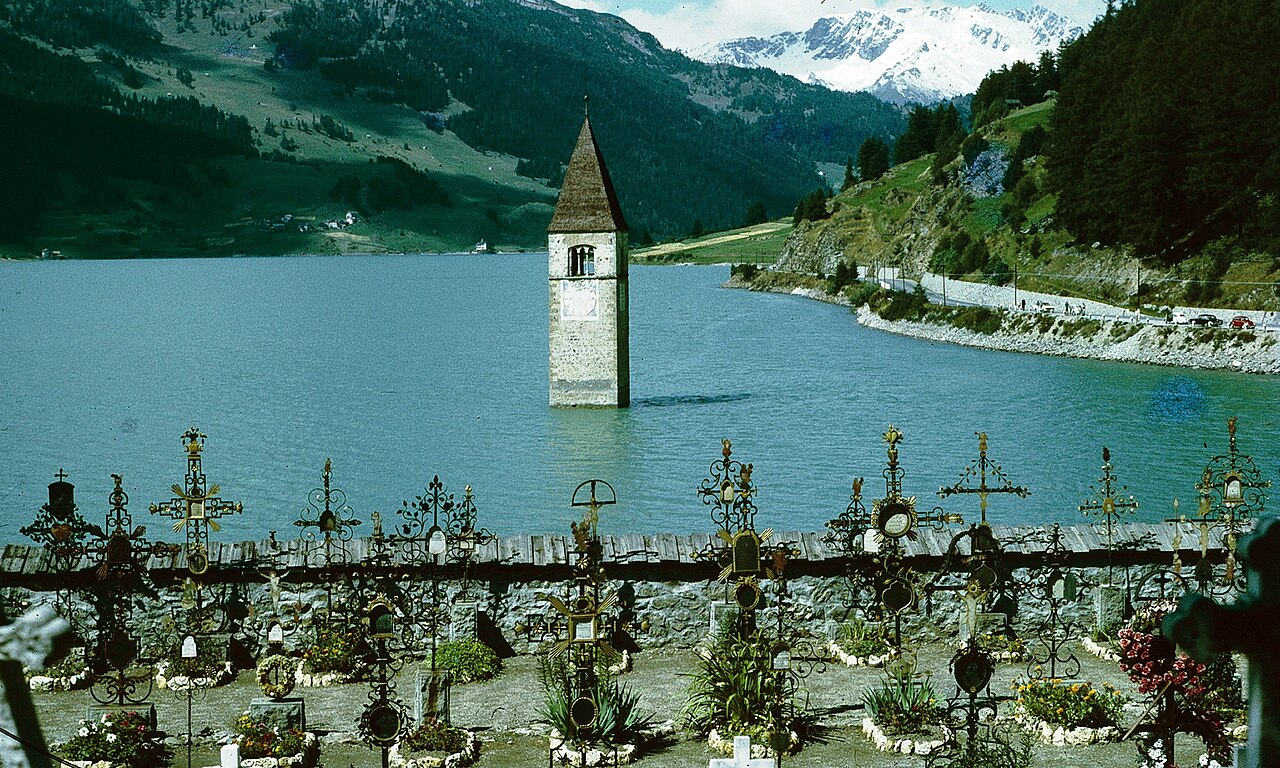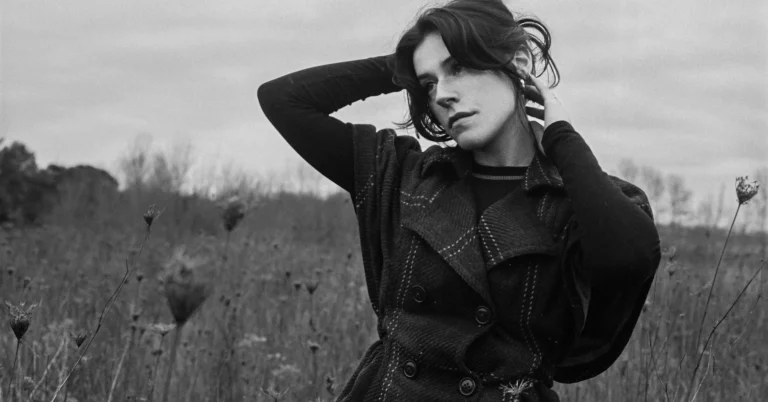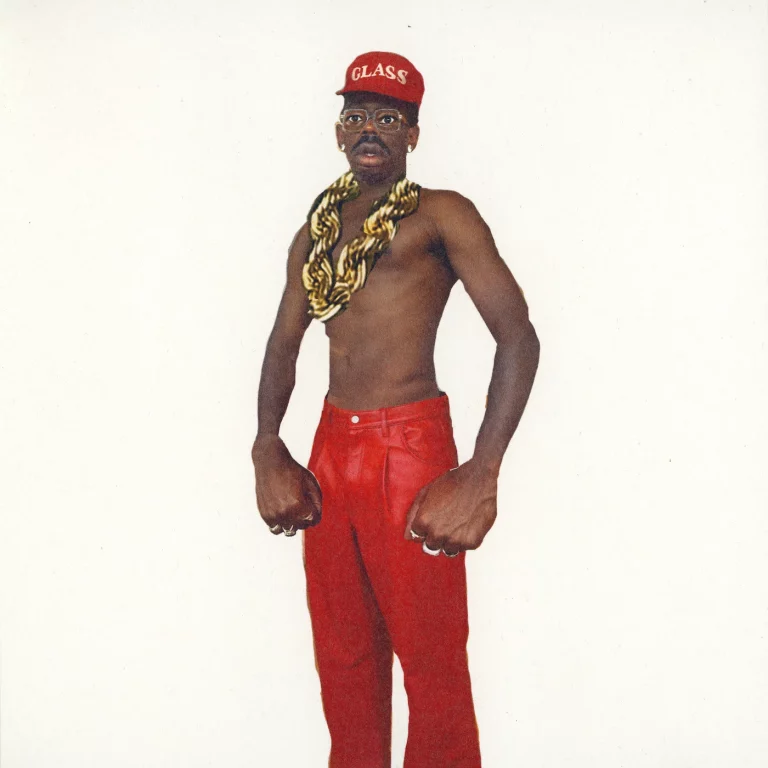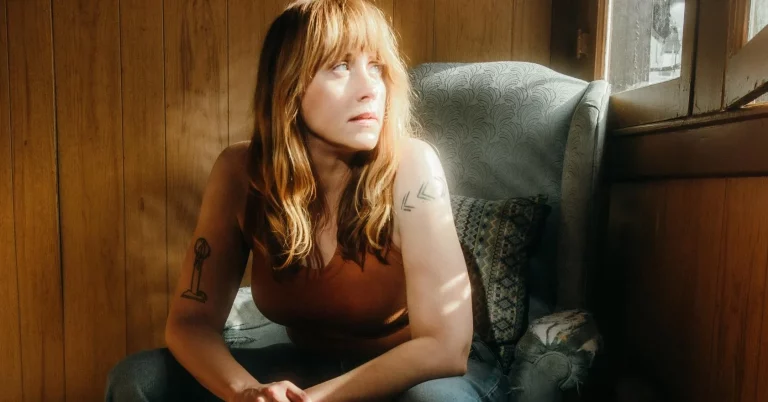Cofiwch Dryweryn (remember Tryweryn). The walls exhort us in bright red and white, from Llanrhystud in West Wales to Chicago. And the writing’s not only on the wall: it’s on a sticker on a lamppost outside Camden Market in North London, on posters and mugs and car bumpers and T-shirts, all the material media you can imagine. Beyond its original referent, it’s been adopted and adapted and repurposed for diverse other ends, too. It rushes through the wires and over the airwaves, in defiance of all and any conventional geography.
What does this modern mene, mene, tekel ask us to remember?
In 1965, sixty years to this, the Welsh-speaking village of Capel Celyn in Cwm Tryweryn, Meirionnydd, North Wales, was cleared and flooded, along with the rural valley in which it lay. The goal was to create a reservoir to provide Liverpool with water for a variety of purposes, by order of the Liverpool Corporation using means which, while legal, entirely bypassed local planning and democratic processes and left the people of Tryweryn disenfranchised and displaced. There was concerted, sustained protest over ten years from 1955 as the Tryweryn development was planned, yet in the end, none could prevent it. Twenty years ago, in 2005, the City of Liverpool offered its recognition of the ‘hurt’ caused a generation since, and an apology for ‘any insensitivity’ in the actions of its predecessor city council.
It was in response to those events of 1955-65 that the words ‘Cofiwch Dryweryn’ were first painted in the early 1960s by poet, author, journalist and scholar Meic Stephens on a ruined wall near Llanrhystud in Ceredigion, at the side of the A487. This coast road might look minor to some eyes. However, it is a key piece of infrastructure, being one of the few main routes from North to South Wales (or South to North, depending on where you are and want to go.) Here, then, the bold slogan commanded – and still commands, for it is still there, albeit by now a lieu de mémoire with a rich, contested history of its own – a massive, mobile readership. It has long since gone on the road itself, taking on a transnational, material and virtual life, as partially documented for instance by the Cofiwch Dryweryn online mapping project, and a recent book with words and colour photographs. As such, this graffiti – and meme – now hold multitudes of meanings which invite analysis in their own right.
But at its origin, Cofiwch Dryweryn was a protest, and simultaneously a call for critical recollection of a specific historical event with emblematic dimensions. It would be overstatement to claim that the Tryweryn controversy alone changed the path of modern Wales. Tryweryn, and Wales, and the very nature of history itself, are all more multi-dimensional than that.
Yet there’s no doubt that the Tryweryn years are of great significance for modern Wales – and all the other loci and histories with which it is linked. The impact of Tryweryn lives on inter alia in politics and the law, and in cultural memory, alongside the legacies of many other dam-building and similar projects, some more controversial than others.
Indeed, it is not fanciful to suggest that an important (if partial) modern Welsh history – all such enterprises are partial – could be written via the history of its hydroengineering, through exploring critically the stories of its dams, its reservoirs and their afterlives. Such a project would need to be a cultural history too, drawing in the astonishing proliferation of Cofiwch Dryweryn graffiti, and a sustained body of other works in many genres and media; it would trace a complex cultural memory.
Sixty years have flowed by since the submersion of Tryweryn in 1965, yet the making of dams and reservoirs in general is no bygone. In fact, constructing massive dams and reservoirs remains a very contemporary, and a very global business. As far back as the year 2000, the World Commission on Dams reported that by the end of the twentieth century, some 45,000 major dams had been built around the world, and that in the 1970s, some two or three new large dams were being projected somewhere every day. Amongst other profound environmental and political impacts, the Commission estimated that by the end of the last millennium, between around 40 and 80 million people worldwide had been permanently displaced from their homes to create dams. One could write a history not only of modern Wales but of the whole world through its reservoirs.
Today, a quarter of a century on from the Commission’s report, the planning and calculating and digging and carrying and building of dams continue apace, primarily in the Global South, yet generally intertwined also with transnational contexts. Thus, many of the people who happen to pass by Cofiwch Dryweryn graffiti from Nebraska to Nefyn to Brighton will have their own memories and stories of other valleys, in so many other places, lost to the control and accumulation of water. Today, then, any critical cultural histories of reservoirs must be comparative, dialogical and engage global connections.
***
In this world, with its terrible ledgers of thirst and deluge, its tensions between old and new energies, finding the right words to encompass the curious effects and affects of engineered lakes might not seem, at first sight, to be our greatest priority. Neither might making close readings of artworks about reservoirs appear to be an especially urgent challenge, as waters rise across the world.
But the Anthropocene demands we think simultaneously on both planetary and molecular scales; about deep time and about right now, and all at once. This is hard to do, very hard: too hard, perhaps, at least most of the time. Perhaps thinking about the stories we tell about dramatically changing worlds can help.
So, in this moment of jeopardy, there might be real value in considering critically our narratives about the control of water, and the language and images we have at our disposal for this work. In this light, a critical exploration of our histories of reservoirs, dams, and of homes lost to flooding, of the displacements of those who lived there suddenly start to look timely – and vital.
It’s not too soon, then, to make notes towards a reservoirian aesthetics, a reservoirian poetics. Here, I don’t mean aesthetics or poetics in the sense of a theorization of beauty but ways of understanding how visual and verbal artworks, and discourse more generally, about reservoirs work, what they might mean. And I say reservoirian, because we’re definitely going to be needing an adjective.
This critical study of representations of intentionally drowned worlds joins hands inter alia with newer disciplines in language and cultural studies: energy humanities, blue humanities, environmental humanities amongst others. Study of language justice will play a part too, because often, the creation of reservoirs often disproportionately impacts linguistically minoritized populations, alongside those who are marginalized in other ways, influentially characterized by scholar Rob Nixon as ‘unimagined communities’.
For reservoir humanities, language matters in further ways too, because we may need new words for new things. At the start of our parched, flooded century, philosopher Glenn Albrecht coined a term for a particular, contemporary sense of loss: that of a familiar landscape erased forever due to climate change. ‘Solastalgia’ is no doubt a word of which we will be making use in future; and it could apply, too, to the way we feel the erasures of environments by grand hydroengineering projects.
But are there words yet for picturing, for those obscure emotions around the loss of a landscape which disappeared before our time; for the painful disappearance of a location where we have never lived, which we have never even seen? And is there a glossary for submerged houses and villages, those topsy-turvy mirror worlds where everything that should be above water is below it? (These are by and large spaces of the imagination, because frequently when reservoirs are created, buildings in the path of the water are demolished, or partially demolished, before it can flow in.) What can we call that peculiar feeling we get from unexpectedly seeing ruins re-emerge from depleted reservoirs in hot summers? Sometimes, creators of reservoirs carefully preserve some spectacular artefact, like a church tower, to rise up from the surface in which it is so knowingly reflected. Such sights are vertiginous. Who will write a lexicon for these loci and things, their images in our minds, in and on water?
Reflecting, mirroring, doubling: these rank among the classic figures of das Unheimliche, the Uncanny, as identified by Sigmund Freud in an essay of 1919. Freud describes the peculiarly unsettling effects produced by something which is simultaneously as familiar as it is strange, and which points obscurely to some terrible, occluded loss. But is the language of the Uncanny the (only) idiom we need for a reservoirian aesthetics and poetics? It’s more difficult, I think, to write on water than on a wall.

Curon Venosta, South Tyrol, 1962. Image by Charles01 via Wikimedia Commons
***
The geographer Erik Swyngedouw has tracked the course of water through dams and reservoirs, through miles of pipes, over viaducts and canals, along the treacherous paths of twentieth-century history and politics in Spain. His book Liquid Power: Contested Hydro-Modernities in Twentieth-Century Spain explores “how water becomes enrolled in the tumultuous process of modernization and development, and how the qualities and powers of water fuse with social, political, and economic processes in the pursuit of social dreams and fantasies”. Swyngedouw says, too, of water in the modern era:
It is the stuff of visionaries and dreamers, bankers and builders, engineers and scientists, workers and peasants, states and industries, peoples and natures. Yet, the transformation of nature and society is also impregnated with vitriolic power struggles, entrenched territorial conflicts, overt or hidden processes of empowerment and disempowerment, of glory and defeat, of life and death. Movies often capture this tumultuous process in ways that scholarly writings rarely succeed in doing.
Swyngedouw offers as an example German director Werner Herzog’s epic film Fitzcarraldo (1982) in which the eponymous protagonist seeks to build an opera house in the Amazon jungle, funded by extracting its natural resources. These efforts culminate in the extraordinary and ultimately failed project of pulling a huge steamship over a mountain by hand, in order to open up an inaccessible waterway for shipping the products of the forest to market.
Swyngedouw’s argument can productively be extended to other forms beyond film, to literary works, and beyond. But as an initial foray into the fragile, topsy-turvy world of the reservoir in art, I take his cue and reflect on two seemingly very different pictures about the flooding of rural communities. The first is the The Last Days of Dolwyn (1949), directed by Emlyn Williams, the celebrated actor, writer and theatre director from North Wales. This UK-made, English and Welsh-language movie is set in an imagined, historical Wales. My second movie is Elem Klimov’s Russian-language film Proshchanie (Farewell) (1983), from the Soviet Union.
***
In 2024, The Last Days of Dolwyn turned 75; it would be good to see this anniversary celebrated, if only in this essay. This was the only film Williams ever directed, and to the (limited) extent that it is at all remembered now, it’s as the young Richard Burton’s screen début. Filming took place on location in Rhydymain in Meirionnydd – not far, as it happens, from Capel Celyn where works on the Tryweryn dam were soon to start. The movie had its Welsh grand première at the Plaza Cinema, Bangor, and then another in Caerdydd.
Six years before the announcement of Liverpool’s plans for the Tryweryn valley, for some of those première-goers, the film, while entirely fictional, would have evoked the history of other, earlier cases of communities drowned to create reservoirs. An example is Llanwddyn in Powys, mid-Wales, close to Meirionnydd, which had to make way for another Liverpudlian project, Llyn Efyrnwy, in 1888.
The Last Days of Dolwyn opens with a present-day frame narrative, in which tourists visit a scenic lake and read a memorial plaque to the village of Dolwyn beneath its waters. The main body of the film then flashes back to show the story of the reservoir’s formation, in 1892.
At that time, Dolwyn lies just below an existing reservoir, in the shadow of a massive dam on higher ground above the village. At the outset, this entirely Welsh-speaking community is full of life and full of people, moving cheerily, busily between chapel and pub, Eisteddfod and flower-show and hymn-singing festival, poaching and theologizing and taking a sly drink on Sundays (a most shocking thing in the Temperance culture of nineteenth-century Nonconformist Wales, and for mid-twentieth century viewers in that tradition too). But something new is afoot: a plan to acquire, clear and flood the village, in order to route water from the reservoir to Lancashire. Other ways of achieving this end are possible, but flooding Dolwyn is the cheapest.
It is proposed that the villagers will be housed in a new estate in the Liverpool suburb of Hagton (nomen est omen), erected by the rich industrialist behind the project, Lord Lancashire, played by Allan Aynesworth. They will then work in his cotton mill nearby, so that the absent lord will not only get hold of the Dolwyn valley and its water but new tenants and workers, too.
Lancashire’s employee Rob Davies (Williams himself) pitches up in Dolwyn, tasked with buying all the land this project requires. For the most part, it is owned by widowed Lady Dolwyn (Barbara Couper), who may live in a grand country house but is so desperately deep in debt incurred by her profligate late husband, that reluctantly, she feels she must sell.
Simultaneously, Rob puts pressure on Lady Dolwyn’s tenants to give up their leases in exchange for some financial compensation. After soul-searching, eventually all agree, yet doubt and fear remain. Gareth, Richard Burton’s character, has just returned to Dolwyn after a miserable period working in Liverpool, a move made in real life of course by many young people from poor North Welsh backgrounds in the nineteenth century and after. The city, he tells his foster mother, is intolerable, with ‘fog all day, and nothing green, mam, not a flower except on women’s hats, and them false, and all the people strangers to each other.’ On Gareth’s account, there can be no flower shows in Hagton.
A date is set for everyone to depart. In a service marking the closure of the chapel, the eloquent minister imagines with his congregation the village filling with ‘waters crawling with the feet of a thousand serpents … under the doors, into the houses, in at the windows, up the stairs, over the roofs, over the nests of birds in the chimneys, over the chimneys. Dolwyn will be drowned.’
Yet, since this film is essentially a melodrama, events take an unforeseen, miraculous turn, hinging on the decisions and actions of its protagonist, Gareth’s foster mother, Merri. She is played by the distinguished actor Dame Edith Evans, then in her sixties and taking her first film role since 1916. Merri is the chapel caretaker and lives in an ancient cottage in the centre of Dolwyn. She is heartbroken at the prospect of drowning the village and losing her home, to a great extent because her son who died in infancy is buried there, under a gravestone which features prominently.
Grief-stricken Merri, unable to contemplate leaving, delays packing her belongings until late in the night before Dolwyn is due to be flooded. But when she finally makes a start, she and Gareth come across an ancient document written in English which Gareth, thanks to his time in Liverpool, is able to read. It proves to be a deed, completely forgotten in family memory, which reveals that Merri is not Lady Dolwyn’s tenant at all, as she had always thought. In fact, one of her forebears was long ago gifted the family’s cottage and plot of land in perpetuity by an ancestor of the landowner’s, in gratitude for saving his life.
This development is quite the spoke in Lord Lancashire’s wheel, as he cannot force Merri to give up her property, and therefore cannot flood Dolwyn. He descends on the village in person to put matters to rights and bend her to his will. But as Merri receives him politely yet confidently for tea in her own home, one property owner to another, he soon realizes she will not be moved, and develops respect for her. Lancashire realizes, too, the unanticipated human costs of his money-making scheme, for at this point we learn that Rob had deceived him by claiming that no-one lived in Dolwyn. And once Merri has managed to alleviate a severe rheumatic pain which afflicts the industrialist by manipulating his shoulder, the two become something akin to friends. Lancashire is convinced that he should spare Dolwyn by selecting a more expensive but less destructive method for obtaining the water from the reservoir, and everyone celebrates.
Everyone, that is, except Rob. In spite of his splendid London clothes and even more splendid London English, and his insistence that he is a cosmopolitan, it transpires that he was once a local lad. Many years ago, as a poor, homeless orphan, Rob stole money from the chapel, and was driven out of Dolwyn in ridicule and shame by other boys. Now he is back for vengeance.
Lancashire’s reasonable, humane volte face is therefore a severe blow for Rob. Wildly, at night, he tries to open the floodgates of the dam to drown the village anyway. When this plan fails, he sets about burning Dolwyn down instead. Gareth intervenes, and tries to stop him, and Rob attacks him. In the struggle, Rob is accidentally knocked down by Gareth and killed. Merri, fearing that her son will be arrested for murder, herself opens the dam so that the water rushes into the village and Rob’s body – and hence, the evidence of his violent death – disappears forever. Thus, in the end Merri drowns her beloved village and the home for which she had fought in order to save Gareth. The film ends as the residents of Dolwyn run for safety in the hills, displaced forever.
The Last Days of Dolwyn is of its time and does not shy away from stereotypes. According to Stephens, some contemporary reviewers expressed scepticism about its ‘Celtic exaggeration’ and its efforts, according to one, to be ‘more Welsh than Wales itself’. The influential reviewer Dilys Powell, in Stephens’ summary, criticized The Last Days of Dolwyn for ‘too many harps harping, shepherd-boys singing and girls hopping’. There are indeed sheep on the village high street; a young shepherd, Huw, who barely speaks, but sings beautifully. Burton gambols like a lamb himself through fields and woods, improvizing with Huw a lovely duet of the traditional song Y Deryn Pur (The Pure Bird, known in English sometimes as The Gentle Bird, The Dove, or The Gentle Dove), and reads psalms in Welsh with his mother at the kitchen table. And as the flood comes to Dolwyn, a harp floats on the water for an instant before sinking; the villagers sing Hen Wlad fy Nhadau (Land of My Fathers) in perfect harmony even as they flee for their lives before the deadly torrent.
These extravagant imaginings of nineteenth-century Welsh life may have been partially responsible for the fact that Williams’s film made relatively little impression in England: launched in London’s Leicester Square, it was in cinemas for only a week. Nonetheless, this film richly rewards study today, not least because it forms an important chapter in both the long history of representing Wales on screen, and the cultural history of Welsh and global reservoirs, and displays unexpected, significant complexity.
If many features in the film can be read as the enthusiastic application of a particularly heavy layer of local colour, they may also be read against the grain. Traditional artforms such as dance and song presented in the film reflect some genuine artistic contemporary practice and expertise in the arts in Wales, albeit in unlikely context and form.
Language in The Last Days of Dolwyn is fascinating too. Aimed as the film was at predominantly Anglophone audiences, most of the key dialogue is, unsurprisingly, in English. Yet it also makes extensive, entirely unsubtitled use of Welsh. The English actor Edith Evans, not a Welsh speaker, delivers her extensive lines in Welsh immaculately. Thus, the seriousness of the film’s treatment of Welsh by Williams, Evans and their collaborators is far removed from what one might expect of mere local colour; such emphatic bilingualism, unmediated by subtitling, seems bold and striking today. In the frame narrative, the English tourists remark of the Welsh-language inscription on the memorial plaque, most nonplussed: ‘not a bit like English, is it?’ Taken alongside the assertive, positive deployment of the Welsh language as a given in the main diegesis, this opening comment might be a subtle challenge to a non-Welsh-speaking audience’s expectations.
Seen in that way, I wonder, too, whether we can’t even read all those harps harping, shepherds singing, sheep bleating, mams chapel-going and tea-pouring in a rather different way. Could it be that the film’s ostentatious effort to be ‘more Welsh than Wales itself’, its excess of stereotypes, at some level draws critical attention to them? In keeping with its frame narrative, in which visitors admire the artificial lake, does it invite viewers to wonder what lies in reality beneath the overly picturesque surface?
On a different tack, The Last Days of Dolwyn, made as it was in the middle of a great dam-building century, expresses something of the fears and fantasies surrounding its topic. On the surface, we see here a nostalgic idealization of rural life in the face of a threatening modernity and industrialization, as embodied by Lord Lancashire’s adventures in hydroengineering.
Yet, like the scenic lake, there is more to this tale than first meets the eye. The film’s imagined past is not uniformly idyllic, as Rob’s backstory of poverty and violent ostracization shows. Indeed, this cruel past resonates through and forms the film’s present. The villains of the piece turn out not to be the landowner Lady Dolwyn, or the industrializing plutocrat Lord Lancashire, but Rob, one of the valley’s own sons; and, more indirectly, the unnamed villagers who in the past failed to take pity on him as a vulnerable boy. Thus, it is not encroaching modernity and modernization which destroy Dolwyn as much as something from a cruel past: an old, unresolved resentment and hatred, expressed in the present as nocturnal, all-engulfing fire and flood. The result is a highly fractured image of village life.
If the film has an ideal, then, it is a more complex fusion of tradition and enlightened modernization, briefly embodied in the entente between Merri and Lord Lancashire. Once Lancashire realizes the human cost of his plan, and that the rights of the people it affects are protected by law, he is keen to carry it out in less destructive ways (though the doubtless significant environmental implications are not explored). Lancashire also recognizes that less modern kinds of knowledge, in the form of Merri’s therapeutic abilities, are valuable. And of course, for all of the film’s old-fashioned air, in fact, as a moving picture, it is an example of the quintessential artform of technological modernity, telling its electric story at twenty-four bright frames per second. The past is dark; the future is light, and somewhere in the clash between them, Dolwyn is lost.
The same ambiguities are not necessarily present of course in all our narratives about the formation of reservoirs. Yet the recognition that their depths are difficult, even where they are apparently simple on the surface, is an important one.
There’s a strange, haunting moment later on in the film between Gareth and Margaret (Andrea Lea), Lady Dolwyn’s niece. We realize that these two, always separated by class and language and culture, have loved one other silently, from afar, for a long time. It is surely no coincidence that the pure bird of Gareth’s song is imagined, in highest Welsh literary tradition, as a messenger from a lad to his distant ‘angyles’, his angel or beloved.
But in the three short, stolen days between the saving and drowning of Dolwyn, an enchanted time where nothing is as it could be before, or after, Gareth and Margaret are together. In a dreamlike sequence set in the woods with Gareth at night, Margaret, in a quiet, faraway voice, observes that if Dolwyn had drowned, ‘by now these trees would have been under water. Shadows. Shadows of hedges. Doors swinging gently on their hinges. But no noise, because it’s water.’ And Gareth says, his tone matching hers, ‘Shadows of people, walking under the water. You and me, looking for each other.’ ‘Don’t.’
In this impossible moment, stolen from the irrevocable onward march of history, Gareth and Margaret picture another, underwater world, the same and yet transformed: familiar shadows under the dark waters. And they relay their imaginings to us through film, itself at times an Uncanny medium, as it preserves the ghostly doubles of its actors on celluloid. The Uncanny submerged world here is itself doubled in turn, in the strangest traces of light on the silver screen.
Thus, The Last Days of Dolwyn speaks not only to dam and reservoir construction, and related displacements, their effects and legacies on a thematic level. It is also, I argue, characteristic of a particular, distinctive aesthetic of the reservoir. In this, for instance, the film resonates astonishingly with the late W.G. Sebald’s classic German-language novel Austerlitz (2001).
Here, in an often overlooked passage, Sebald’s protagonist learns of the drowned village of Llanwddyn. He thinks of it in startlingly similar terms to Margaret and Gareth’s imaginings of Dolwyn, as a shadowy, spectral world where villagers walk forever in silence under the water. Lost Llanwddyn is, like Dolwyn, imagined as falling victim to a kind of violent retribution, watery and fiery, for past sins or crimes. To my knowledge, there is no evidence in the public domain that Sebald knew Williams’s film. Nonetheless, the language of intertextuality allows us to speak of their similarities as comparable refractions, as in water, of something important. This is the reservoirian Uncanny.
***
Proshchanie is based on a novel of 1976 by Valentin Rasputin, which was likely influenced by his own experience of seeing villages in his home region, Siberia, cleared in the 1960s to create reservoirs. Originally, this film was planned by director Larisa Shepitko. However, following her untimely death in 1979, along with four colleagues, in a car accident while scouting for locations, her widower Klimov took the project forward. The Soviet authorities’ response to this work seems to have been at best hesitant, probably due in part to its depiction of the anguish of a community destroyed in the name of Socialist progress, and what we might today call its eco-critical stance. Proshchanie was only released in 1981, two years after its completion, and then only on a small scale. Foreign audiences had to wait for a further three years, and glasnost, before it could be shown outside the USSR.
Proshchanie depicts the last days of Matyora, a village on an island in a large river or lake, in an unnamed countryside. The inhabitants bring in their last harvest and follow the orders of local Soviet official, Vasily Vorontsov (Aleksei Petrenko), to clear their homes. They then are required to raze these elaborate, ancient wooden buildings to the ground, because not a single house or tree should still be standing when the waters rush in. The plan is to create a reservoir for a new hydro-electric power station which will serve a host of new plants and towns. The residents of Matyora will be displaced to modern, yet flimsy-looking, apparently barely finished apartments on the mainland. Presumably, just like the people of Dolwyn, their future employment will lie in modern, heavy industry, rather than farming life inherited from generations of forebears.
The plot focuses on some villagers and their responses, primarily the elderly Darya Pinegina, played by Stefaniya Stanyuta, and her son Pavel Pinegin (Lev Durov). While Vorontsov makes powerful appeals to a better future in the wake of modernization, Darya cannot bear the thought of leaving Matyora and her parents’ graves, and grieves too for its natural environment. Pavel has been appointed, against his wishes, by Vorontsov to manage the clearing of the village, and in the process mother and son are painfully torn apart.
Families leave one by one, burning down their beautiful houses as they go. Boats fetch first the children, then the livestock. And those who stay in Matyora until the very end begin to lose themselves. Pyotr Zotov (Leonid Kryuk) takes to drink and sets fire to his house, even though a museum has offered him a generous sum for it as a heritage artefact, and plans are in place for transporting it to safety. Others, too, start to show signs of a kind of derangement.
Darya, five other women, a little boy who is mute, and one old man ignore all orders to leave by the appointed date, and refuse to board a launch sent at the last minute to collect them. In the film’s final scenes, early the next morning, when the village should already be entirely empty and ready to be flooded, Vorontsov, Pinegin and Zotov take a boat to Matyora in search of these resisting villagers. (This sequence recalls, to my eyes, something of the hallucinatory final sequences of another film by Herzog, Aguirre: The Wrath of God (1972) – and which, set as it is on a river of madness and no return, has powerful affinities with Fitzcarraldo, referenced by Swyngedouw.)
In fog and the half-light of dawn, the three men fail to find Matyora at all, although they know exactly where it should be. Fear and a sense of bizarre uncertainty set in: has the flooding taken place early, the men wonder; is Matyora already submerged? Or has it vanished? Vorontsov lights a torch, shouts wildly. And in the film’s final, nightmarish frames, he and his companions men see fire, darkly – is Matyora’s last house, Darya’s, burning? What has become of Darya, the child, the women, the old man? The film ends.
Proshchanie is in many ways a reasonably conventional realist drama. Yet to me, at least, a strangeness in its storytelling and its still, slow, extended shots of singular objects and unexplained events render it recalcitrant, resistant to interpretation, difficult. Indeed, it was only on my third or fourth viewing that I felt that I was beginning to grasp something in its enigmatic vignettes.
For example, in the opening moments, before the viewer has any bearings at all, we see from some distance a group of figures travelling in a small boat through mist. Each one wears a strange cloak with a high, pointed hood, and it all looks like a Symbolist or mythological painting, or an absurdist film, somewhere in between Alfred Böcklin’s series Die Toteninsel (Isle of the Dead) (1880-1901) and Samuel Beckett’s television mime Quad (1981). It’s only much later on that we realize that these figures are in fact a team of workers sent to help demolish Matyora and fell its trees – wearing very ordinary raincoats.
(A few days after first drafting the above paragraph, I learned something about this scene from Kathleen Parthé’s foreword to Antonina W. Bouis’s English translation of Rasputin’s novel. Parthé notes that while there are five figures in the boat in the opening sequence, only four of them later reappear as workers on the island. The fifth has disappeared. According to Parthé, this is Klimov’s tribute to Sheptiko and her colleagues who passed before the film was made. So, on watching and re-watching, layer after layer come to light. Perhaps this, too, is part of a reservoirian aesthetics, in which things reveal themselves only fitfully, occasionally, dependent entirely on weather and light conditions.)
So, to my mind, Proshchanie is a difficult film which insists that watching is a strenuous matter, that understanding art is labour: it demands work from its viewer, the work of looking, of waiting to see. Pertinently perhaps, there is considerable emphasis in the diegesis on the act of watching, which becomes a kind of Leitmotif. Often, one character or group of characters just stands still, and looks on at events. (Rainer Werner Fassbinder, observer extraordinaire of staring, joins Herzog and Beckett alongside me, in the auditorium of my mind.)
***
Any comparison of these two films, The Last Days of Dolwyn and Farewell to Matyora, demands caution. For one thing, (perceived) differences and similarities can be contingent, mutable; they depend, too, on who is watching. For a viewer who, like me, grew up in North Wales, The Last Days of Dolwyn for all its unlikely harps harping, et cetera, leans into some highly familiar, legible fantasies of the past. By contrast, my first impression of Klimov’s Proshchanie was one of startling novelty. Yet to a different spectator, one who might be less excited than me at the prospect of an Eisteddfod, less despondent when one is cancelled, one who might not know that ‘Y Deryn Pur’ is about a blue bird on the wing and an unattainable love, Williams’s film might seem more alien than Klimov’s. Nonetheless, contrast and comparison of these two films prove remarkably intriguing.
On the surface, beyond the shared theme of reservoir-making, these pictures seem quite different. The people of Matyora are considerably more rebellious, more carnivalesque than the rather (if not entirely) sedate inhabitants of Dolwyn. Their wooden homes burn so much more easily than heavy grey stone. In form too, the films differ. The Last Days of Dolwyn is filmed in black and white, while Proshchanie seems subtly to shift between colour and monochrome. Klimov’s depiction of a village’s last days and its residents’ preparations to leave their homes is more detailed and expansive than Williams’. And yet, his storytelling and visual style slip between a kind of realism on the one hand, and something more experimental, avant-garde on the other (Bertolt Brecht takes a seat next to Fassbinder; I start to wonder why I haven’t invited more women to join me in my imaginary cinema.) The diegesis of The Last Days of Dolwyn is conventional, easy to follow, at times comedic. Proshchanie has more tragedy about it, laced with moments of absurd humour; its ending is open and ambiguous, while that of The Last Days of Dolwyn is – apparently, at least – closed.
And yet, these two films shadow one another in curious ways; again, mysterious reflections and refracted doublings begin to emerge. Both films open with images of flowing water; both have catastrophic final scenes, shot through with water and fire which show, in half-light, burning villages on the verge of being flooded. Alerted by this consonance, it is astonishing to realize how many further tropes and themes they share, above and beyond the story of a traditional, rural village drowned in the name of progress, industrialization and modernization.
For instance, both films feature an unnamed boy or youth, who observes, but barely speaks, or does not speak at all, as well as elderly women protagonists who cannot bear to leave their homes, or their loved ones’ graves. Both Merri and Darya embody and defend an old way of life, and their houses are lined with pictures of their ancestors: a cloud of witness. These women take tea ritually: in one home the teapot, in the other, the samovar, is their talisman. In Proshchanie, the importance of the samovar as the emblem of the home is underlined ironically when a departing woman from the village, weeping as she closes the door of her house forever, is advised to follow what sounds like a traditional custom: not to cover up the samovar in her baggage, so that it can find its way back home.
Generational themes sound loud and clear in both films, and their clashes between older women and younger men are particularly striking. Here, elderly mothers symbolize continuity, family, community, memory; younger men, Rob Davies and Pavel Pinegin, are their opponents, albeit unwillingly, in Pavel’s case. Rob’s hostility towards Dolwyn is linked to his destitute, outcast childhood. Not having a mother of his own, yet likely knowing that Merri took in two other orphan boys, Gareth and his brother, he seems to be incandescent with rage and envy, to the extent that that figure of speech becomes quite literal, as he attempts arson. Pavel’s position and pain in Proshchanie are different, for he suffers at least partly because his mother suffers.
But in both cases, a conflict between mother and a younger man, her son or a son-figure, lies at the heart of the matter. In both cases, then, there is a narrative about matrilinearity, maternal figures, the feminine in conflict with a modernity which is coded as masculine that demands our attention. The implication is that representations of making reservoirs may be gendered in powerful ways.
***
So we look back at Dolwyn and Matyora; in order, certainly, to remember and to understand what has been; to start to grasp, too, the world today. We would also be wise to look back at Llanwddyn and Capel Celyn, at Riano, Narmada, Hasankeyf, Altamira, Vitória do Xingu. At Curon Venosta / La Carun / Graun in the Venosta Valley, Ada Kaleh, and many more.
We might do so perhaps, too, as a way of looking ahead, however partially. Like Vasily Vorontsov, who is losing his mind on the dark water, flaming torch in hand, in the twilight and smoke. Towards the day after tomorrow, where waters may flow under doors, into the houses, in at the windows, up the stairs, over the roofs, over the nests of birds in the chimneys, over the chimneys. What feet will crawl serpentine through the waters then; what silent ghosts will move through them?
Mene, mene, tekel.








